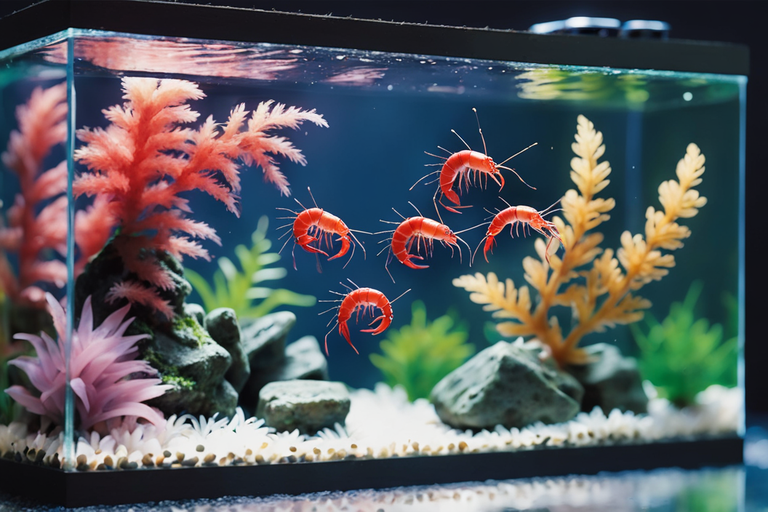Are you interested in caring for cherry shrimp? Look no further! This guide has everything you need to know about their size, tank mates, and care.
Discover the key tips for maintaining their water quality and ensuring their well-being.
Learn about their breeding and reproduction process to ensure a successful colony.
With this informative and scientific guide, you’ll become an expert in cherry shrimp care in no time.
Let’s dive in and explore the fascinating world of these colorful crustaceans.
Understanding Cherry Shrimp Size
You’ll find that cherry shrimp size can vary between 1 and 1.5 inches in length. Cherry shrimp growth is influenced by a variety of factors, including genetics, water conditions, and diet. These tiny creatures have the ability to molt, shedding their exoskeleton to allow for growth. During this process, they may appear temporarily smaller before their new shell hardens.
To ensure optimal growth and size, it’s crucial to provide them with a balanced diet. Cherry shrimp are omnivores, meaning they eat both plant matter and small organisms. Their diet can consist of algae, biofilm, blanched vegetables, and high-quality shrimp pellets or flakes. Offering a diverse range of food sources will support their growth and overall health.
Choosing the Best Tank Mates for Cherry Shrimp
When integrating cherry shrimp into an aquarium, it’s vital to consider their gentle nature and susceptibility to predatory threats. Their cohabitants must be carefully chosen to ensure a harmonious environment. Here’s a refined guide:
- Size Matters: Given the cherry shrimp’s petite stature, opt for tank mates of similar or non-threatening size. Ideal companions include:
- Celestial Pearl Danios: These tiny, colorful fish will coexist without viewing the shrimp as food.
- Endler’s Livebearers: A small, peaceful species that won’t disrupt your shrimp.
- Pacifist Preferences: A serene environment is key for cherry shrimp. Stick to non-aggressive species that are unlikely to harass them:
- Otocinclus Catfish: These algae eaters are both beneficial and non-threatening to shrimp.
- Dwarf Rasbora: Their calm demeanor and small size make them ideal tank mates.
- Environmental Alignment: While you didn’t request more on this, it’s worth noting to always ensure the chosen tank mates have similar requirements in terms of water parameters to ensure a stress-free habitat for all.
Essential Care Tips for Cherry Shrimp
To keep your cherry shrimp healthy and thriving, it’s important to maintain stable water parameters and provide plenty of hiding spots in their tank.
When it comes to tank setup, cherry shrimp prefer a well-established aquarium with live plants, which provide them with hiding spots, food sources, and a place to lay their eggs.
You should also ensure that the water parameters are suitable for cherry shrimp. They thrive in slightly acidic to neutral water with a pH range of 6.5 to 7.5, and a temperature between 72°F and 78°F.
Additionally, cherry shrimp have specific feeding requirements. They’re omnivorous and will eat a variety of foods, including algae, biofilm, and small particles of organic matter.
You can supplement their diet with commercial shrimp pellets or blanched vegetables like spinach or zucchini. Remember to provide a balanced diet and avoid overfeeding to maintain optimal health for your cherry shrimp.
Maintaining Water Quality for Cherry Shrimp
Keeping the water clean and free from pollutants is essential for the health and well-being of your cherry shrimp. To maintain optimal water quality, it’s important to monitor and maintain the following water parameters:
- Temperature: Cherry shrimp thrive in water temperatures between 72-78°F (22-25°C). Fluctuations outside of this range can stress or even harm them.
- pH Level: Aim for a slightly acidic to neutral pH level between 6.5-7.5. Extreme pH levels can be detrimental to the shrimp’s health.
- Ammonia and Nitrite Levels: These toxic substances can build up in the water and harm cherry shrimp. Use a reliable test kit to regularly check and ensure ammonia and nitrite levels are at zero.
- Filtration System: Invest in a good quality filter to remove debris and maintain water quality. A sponge or sponge filter is often recommended for cherry shrimp tanks as it provides a gentle flow and acts as a biological filter.
Regular water changes, about 10-20% every week, are also crucial for maintaining pristine water conditions for your cherry shrimp. Remember to condition tap water to remove chlorine or chloramine before adding it to the tank.
Breeding and Reproduction of Cherry Shrimp
To successfully breed and reproduce cherry shrimp, it’s important to create a conducive environment with plenty of hiding spots and a balanced diet.
Breeding cherry shrimp can be a rewarding experience, as it allows you to increase your shrimp population and observe the fascinating life cycle of these tiny creatures.
One of the benefits of breeding cherry shrimp is the ability to create a self-sustaining colony in your aquarium. This means that you won’t have to purchase new shrimp every time you want to add more to your tank.
However, there are also challenges to consider. Cherry shrimp can be sensitive to water parameters, so maintaining stable water conditions is crucial. Additionally, ensuring a proper ratio of males to females is important for successful breeding.
Conclusion
In conclusion, cherry shrimp make fascinating and vibrant additions to any aquarium. By understanding their size, choosing compatible tank mates, and providing essential care, you can ensure their well-being.
Maintaining water quality is crucial for their survival, as it directly affects their health. Additionally, if you’re interested in breeding cherry shrimp, proper conditions and knowledge of their reproductive behavior will be necessary.
With the right care and attention, these colorful shrimp will thrive and bring beauty to your aquatic ecosystem.

